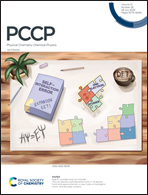Finding the optimal exchange–correlation functional to describe the excited state properties of push–pull organic dyes designed for thermally activated delayed fluorescence†
Abstract
To gauge the suitability of an organic dye for thermally activated delayed fluorescence (TADF), its excited state properties are often calculated using density functional theory. For this purpose, the choice of the exchange–correlation (XC) functional is crucial as it heavily influences the quality of the obtained results. In this work, 19 different XC functionals with various amounts of Hartree–Fock (HF) exchange and/or long-range correction parameters are benchmarked versus resolution-of-the-identity second-order coupled cluster (riCC2) calculations for a set of 10 prototype intramolecular donor–acceptor compounds. For the time-dependent density functional theory (TD-DFT) calculations, LC-BLYP(ω = 0.20) and M06-2X are the better performing XC functionals when looking at singlet and triplet excitation energies, respectively. For the singlet–triplet energy gap, LC-BLYP(ω = 0.17), LC-ωPBE(ω = 0.17) and a hybrid LC-BLYP(ω = 0.20)/M06-2X method give the smallest mean average errors (MAEs). Using the Tamm–Dancoff approximation (TD-DFT/TDA), the MAEs are further reduced for the triplet vertical excitation energies and the singlet–triplet energy gaps.



 Please wait while we load your content...
Please wait while we load your content...